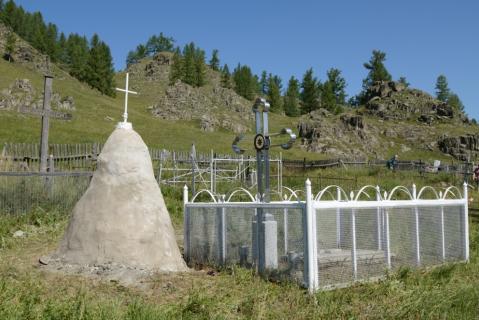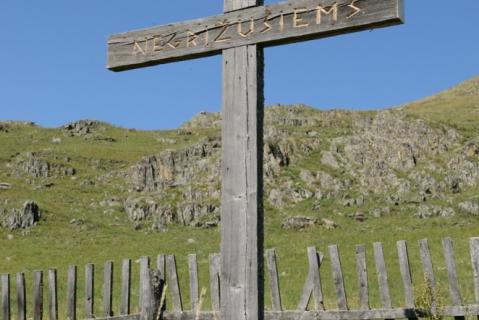In 1941, in response to the 16 May 1941 Politburo resolution, deported Lithuanians were allocated to the Ozernoe village in the Ongudaisky district. Their exact number is unknown. Those who died were buried according to Catholic rites in a separate section of the graveyard, with crosses and name plates on their graves. The total numbers who died have not been established; only ten names are known. In 1965, a former deportee Julija Čekanauskienė who had stayed behind in Ozernoe, erected a memorial in the graveyard to fellow Lithuanians who had died there in exile: it took the form of a cairn surmounted by a Catholic cross.
In 1990, former deportees and their relations visited the graveyard and put up a wooden commemorative cross there. In 1991, Lithuanian researcher Gintautas Alekna studied the graveyard, carried out a photo survey, uncovered 12 graves with surviving headboards, and drew up a plan of their layout. In August 2012, members of the “Destination, Siberia!” youth expedition from Lithuania worked in the graveyard. They cleared the territory, restored the 1965 monument, raised the 1990 cross which had fallen down, and painted the fence around Julija Čekanauskienė’s grave.
Research on the Genocide of the Lithuanian People (Lietuvos gyventoju Genocidas; 3 vols. 1999-2009) contains about 130,000 biographical entries (in Lithuanian). Vol. 3 covers the years from 1948 onwards and see Deportation of Lithuanians, 1941-1951 for the 29 other burial grounds and commemorative sites on the Map of Memory.
The Memorial online database (2025) lists 7,379 victims in the Altai Republic (see Gorno-Altaisk).
The republic’s Book of Remembrance includes 11 Lithuanians.
| Date | Nature of ceremonies | Organiser or responsible person | Participants | Frequency |
|---|---|---|---|---|
|
nk
|
Commemorative Services
|
nk
|
nk
|
From time to time
|
| State of burials | Area | Boundaries |
|---|---|---|
|
12 headboards have survived
|
not defined
|
not delineated
|
[ original texts and hyperlinks ]
Note on the 1991 expedition by the Genocide and Resistance Research Centre of Lithuania
“Ekspedicija Altajus 2012”, Lemtis (Destiny) association website (in Lithuanian)
G. Alekna, “Ekspedicija 2012. Altajus Oziornoje” (YouTube film) retrieved 26 May 2022


